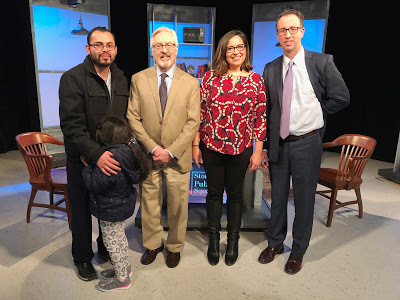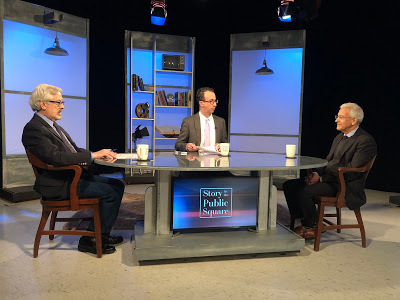Inside Story

In conjunction with Story in the Public Square, the weekly Rhode Island PBS/SiriusXM Satellite Radio show I co-host and co-produce with Pell Center head Jim Ludes, I write an occasional column, Inside Story, for The Providence Journal. And I frequently produce a podcast from these shows.
We have a marvelous range of guests -- noted scholars and storytellers from the worlds of film, TV, still photography, books, journalism, social activism, academia and more -- more than a few Pulitzer and other prize-winners -- and I highly recommend you see the full slate at the Story in Public Square episode site. Story is a partnership of the Pell Center, where I am a visiting fellow, and The Providence Journal, where I have been a staff writer for many years.
So let's get to it. I will archive my Inside Story columns -- and links to the podcasts -- here on my blog, and I invite you to read... and to download and listen. I always welcome feedback, and suggestions for guests. We are in Season Three and growing, so welcome to the family!
-- Weekend of February 17, 2018: Immigration, Latino issues, with guest Gabriela Domenzain.
LISTEN TO THE PODCAST
I knew from meeting Gabriela Domenzain last fall that she would soon make her mark in Rhode Island. The newly arrived head of Roger Williams University’s Latino Policy Institute, Domenzain brought impressive credentials from her time in Washington, the national media and the Hispanic advocacy organization National Council of La Raza, now known as UnidosUS. With her distinctive energy, Domenzain, the daughter of Mexican immigrant doctors, got right to work on Latino issues, including significant educational and economic disparities here and across the nation.
But the public has come to know her best with her recent involvement in the case of longtime Rhode Island resident Lilian Calderon, wife of U.S. citizen Luis Gordillo and mother of their two young children who this week was released after a month in federal detention. Thirty years old now, Calderon came to America from Guatemala as a 3-year-old, and in January she was seized by ICE, the U.S. Immigration and Customs Enforcement agency. Her story made national headlines as Congress once again tackles the hot-button issue of immigration.
 Gordillo, daughter Natalie, Miller, Domenzain, and Ludes on setSo we were keen to discuss that case and the larger issues surrounding it with Domenzain, this week’s guest on “Story in the Public Square,” TV and radio. Her intimate knowledge of immigration and her life experiences give Domenzain an authority that is often lacking in the local and national conversations, when some people are quick to post Facebook comments and fire off tweets based on hot emotion and misinformation, not cold facts.
Gordillo, daughter Natalie, Miller, Domenzain, and Ludes on setSo we were keen to discuss that case and the larger issues surrounding it with Domenzain, this week’s guest on “Story in the Public Square,” TV and radio. Her intimate knowledge of immigration and her life experiences give Domenzain an authority that is often lacking in the local and national conversations, when some people are quick to post Facebook comments and fire off tweets based on hot emotion and misinformation, not cold facts.Lilian, Domenzain said, was seeking to set her record straight when “she was literally vanished from her community without any explanation.” For Domenzain, it represented a chilling change of tactics by federal authorities. It was one of the first such in New England, she said — but not the last in the region and country, she fears, under the Trump administration and a Republican-controlled Congress.
How did we get here? we asked. Efforts at comprehensive immigration reform date to the presidency of Ronald Reagan, more than three decades ago.
From the GOP side, Domenzain said, an explanation can be found in those congressional Republicans who bitterly opposed Barack Obama in his first term. “A backlash,” she called it, led by extremists who understood that a hard-line anti-immigration stand would appeal to some white voters and might prevent America’s first African-American president from winning a second term.
“We’re talking about the Tea Party and the very, very right fringe extreme caucus that is now in the middle of the Republican Party,” Domenzain said. “It used to be fringe. Now it’s actually front and center.”
Across the aisle, Domenzain asserted, other factors were in play.
“On the Democratic side, they haven’t decided to use their political capital on these issues,” she said. “President Obama tried his first year. It didn’t work. He decided to go with health-care reform, which, by the way, was the number-one priority for Latino voters because we are the most underinsured and uninsured population.”
Like many others, Domenzain sees this year’s elections as potentially game-changing. Surveys suggest that greater numbers of Hispanic, African-American and other traditionally non-Republican voters will cast ballots than in 2016.
That, she said, does not bode well for today’s Washington.
“The Republican Party has no chance with Latinos right now. They have the most anti-immigrant, racist president in the history of this country and Latinos recognize that they’re scapegoats.”
I have only touched on our wide-ranging conversation (which, I would note, Lilian’s husband and one of the children watched from the control room). Wherever you stand on the immigration debate, this is a broadcast well worth hearing or watching.
*****
-- Weekend of January 27, 2018: Genocide, the Holocaust, with guest Omer Bartov.
LISTEN TO THE PODCAST
On Saturday, the world marks International Holocaust Remembrance Day, #WeRemember, in honor of the 6 million Jewish victims of Nazism and the millions of others killed when Hitler was in power. So it is appropriate that during this weekend’s TV and radio broadcasts of “Story in the Public Square” we feature Omer Bartov, the esteemed Brown University historian who has written extensively about Nazi Germany and ethnic cleansing.
His latest book, “Anatomy of a Genocide: The Life and Death of a Town Called Buczacz,” published this week by Simon & Schuster, is an extraordinary story of how one small town in Eastern Europe descended into unspeakable atrocity in the first half of the 20th century.
 Miller, Ludes, Bartov.
Miller, Ludes, Bartov.“Genocide is often being studied from the top,” Bartov tells us on “Story in the Public Square,” “from the point of view of the perpetrators: how was it organized, how do you organize the mass destruction of a group. One of the ideas in explaining that was you have to dehumanize people, that you have to think of them as different from us, as not normal.”
In “Anatomy of a Genocide,” Bartov focused on the border town of Buczacz, which is today part of Ukraine. Before Hitler and Stalin, the Jewish, Polish and Ukrainian residents there had gone centuries without conflict.
“I wouldn’t say it was a harmonious coexistence, but they lived together and they did not know any other reality,” Bartov said. “This was what they had always done.”
“They didn’t have gangs and killing squads or anything of that sort,” I said.
“No, no, no.”
“They had their differences, but they lived together.”
“Yes,” Bartov said. “They lived side by side quite peacefully. And they often speak each other’s languages, they go to school together.”
As World War II unfolded, German authorities took control of Buczacz after driving out the occupying Soviets.
“The mass killing begins in the late summer, early fall of 1942,” Bartov said, “and by spring 1943 most of the Jewish population in that town has been murdered, about 10,000 people. So by June 1943, this area is decreed by the Germans ‘clean of Jews.’”
“Who did the killing?” my co-host Jim Ludes asked.
“The killing of the Jews is done primarily by about 20 to 30 Germans who are members of the security police,” Bartov said.
Police, not soldiers.
And not at Auschwitz or Dachau, but in Any Town in East Europe — as neighbors watched and, in some instances, cooperated.
As the Bosnian and Rwandan genocides and other ethnic cleansing after (and before) World War II demonstrate, the Holocaust was not unique. Given the right, terrible conditions, human nature can turn horrific.
Bartov explained how ordinary people can conspire in such a descent into the worst darkness.
Say, for example, he told us, “you live in a house and the house has four stories and the people upstairs have the nicest apartment and they have a piano and they’re taken out by the police and shot on the street. You had nothing to do with it. You were friends, your daughters went to school together. Now what happens to their apartment? Who is going to live there? If you don’t move in — it’s a nicer apartment, it has better air, it’s the fourth floor, it has a piano — somebody else will.
“So you move in. And once you’ve moved in, well, you are already part of this process. On the local level, there are no simple victims, perpetrators, and bystanders. Everyone is involved in this process. Everybody gets roped in in one way or another. And the veneer of civilization — of saying hello to your neighbors in the morning — suddenly disappears.”
This process of demonizing or dehumanizing someone who is racially, ethnically or religiously different, Bartov says, is key. He sees similar social dynamics at work today in many parts of the world, including America, where racism and nativism bring headlines.
Born and raised in Israel, where he served four years in the army, Bartov is the son of a woman who grew up in Buczacz, so there is a strong personal element to “Anatomy of a Genocide.” Hear more about that and Bartov’s latest book this weekend on “Story in the Public Square.”
Published on February 17, 2018 15:07
No comments have been added yet.



